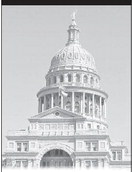STATE CAPITAL HIGHLIGHTS
By Gary Borders
Texas public schools received more than $19 billion in pandemic relief funds over the last four years, but that pipeline of cash will largely end Sept. 30, The Texas Tribune reported.
That means many Texas schools already struggling with budget deficits will begin the school year with even more serious deficits, especially since the Legislature has not increased base per-student pay since 2019 — a year before the pandemic began.
Congress passed the Elementary and Secondary School Emergency Relief package in 2020 to help schools deal with the impacts of the COVID-19 pandemic, which caused enrollment declines, teachers exiting the profession and falling test scores. That funding is about to end, with essentially nothing to take its place for many school districts already at the maximum allowed property tax rate.
“It’s not about making up ESSER, because we all knew that was one-time funding,” said La Joya Independent School District Superintendent Marcey Sorensen. “I just would ask, without getting political whatsoever, that everybody just look in the mirror and say, OK, if we really haven’t provided additional funding since 2019, maybe it’s time that we just give school districts a little bit more of what they need, knowing that kids have different needs now.”
A recent survey conducted by the Texas Association of School Business Officials concluded that out of 313 school districts across the state, nearly 80% reported deficit budgets or a lack of resources as one of their top challenges.
Abbott orders hospitals to report immigrant-care data
All Texas hospitals enrolled in Medicaid or the Children’s Health Insurance Program have been ordered by Gov. Greg Abbott to report costs incurred by treating undocumented immigrants, the Austin American- Statesman reported. In a news release outlining his executive order, Abbott blamed the Biden administration’s border security policies for health care costs related to those immigrants.
“Texans should not have to shoulder the burden of financially supporting medical care for illegal immigrants,” Abbott said.
Some Democratic lawmakers criticized the order.
State Rep. Gene Wu, DAustin, posted on X: “Texas has the HIGHEST uninsured healthcare in the nation. Texas has the WORST mental health care in the nation. Texas has one of the worst (mortality) and infant mortality rates in America. But these are the Republicans priorities.”
Five more counties added to disaster list
In the aftermath of Hurricane Beryl, five more Texas counties have been added to the federal disaster list, the governor’s office announced.
The counties of Austin, Bowie, Shelby, Trinity and Waller have been added to the list, which already included Brazoria, Chambers, Fort Bend, Galveston, Harris, Jackson, Jasper, Jefferson, Liberty, Matagorda, Montgomery, Nacogdoches, Orange, Polk, San Jacinto, Walker and Wharton counties.
Texans can apply for FEMA disaster assistance online at disasterassistance.gov or by calling 800-621-3362.
SUBHED: Carbon monoxide poisonings spike in wake of storm Carbon monoxide poisonings rose dramatically in the wake of Hurricane Beryl, with about 400 people ending up in Texas emergency rooms since the storm struck on July 8, the Texas Standard reported. That is the highest number reported since the 2021 winter storm, added the Standard.
Two people died of CO poisoning in Harris County.
CO poisonings caused by widespread power outages are growing more common as climate change causes additional extreme weather events, according to scientists.
“Whether you want to blame it on this, that or the other, I don’t care. The world is changing. The climate is changing,” said Dr. David Persse, Houston’s chief medical officer.
School about to start; watch for the kiddoes
With school about to start, drivers are urged to stay alert and exercise caution in school zones, the Texas Department of Public Transportation advised. School zones can be chaotic, and 748 crashes were reported inside them last year. In addition, 2,523 collisions involving school buses occurred in Texas last year, killing 11 people and injuring 63.
TxDOT has launched its “Be Safe. Drive Smart Back-to-School” campaign in hopes of reducing crashes. The most common causes of crashes are preventable, such as speeding, distracted driving and failure to yield the right of way.
Among the tips offered by TxDOT:
•Be aware. Traffic patterns around schools may have changed since last school year.
• Stay alert and put your phone away. Using a handheld electronic device while driving in an active school zone is against the law.
• Stop and yield the right of way to a pedestrian, bicyclist or other vulnerable road user in a crosswalk. The Lisa Torry Smith Act of 2021 enhanced the penalties for failing to follow the law and protect people in crosswalks. Seriously injuring someone who is lawfully in a crosswalk is now a state jail felony.
• Obey school-zone speed limit signs. Remember, traffic fines increase in school zones.
• Know where to go. Drop off and pick up your kids in your school’s designated areas, not the middle of the street.
• Be on the lookout. Keep an eye on children gathered at bus stops.
• Watch for children who might dart across the street or between vehicles.
Yup, it’s hot in Texas
Exactly how hot is it in the Lone Star State as a heat dome covers much of Texas during these dog days of August? According to the Statesman, the state has the fourth-highest average temperature so far this year, coming in at 65.8 degrees. That might not seem all that hot, but keep in mind it includes temps recorded in January averaged in with that summer heat.
Topping the list of hottest states is Florida, followed by Hawaii and Louisiana, according to data compiled by a blogger. After Texas comes Georgia, Mississippi and Alabama. Surprisingly, Arizona — even with triple-digit temperatures recorded regularly around Phoenix — is tied for ninth place.

.jpg)
